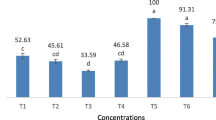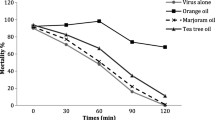Abstract
Nuclear polyhedrosis viruses isolated from the alfalfa looper,Autographa californica (Speyer) (AcMNPV), and a mint looper,Rachiplusia ou (Guenée) (RoMNPV), were assayed against the European corn borer,Ostrinia nubilalis Hübner), and applied to field corn for suppression of this insect. Fourteen days post-treatment, LC50 values were 46.50 abd 0.95×105 PIB/ml diet for AcMNPV and RoMNPV, respectively. Both viruses caused significant reductions in number of larvae per plant and in plant damage when the material was applied with a backpack sprayer. Data indicate that RoMNPV kills in less time than AcMNPV. When the viruses were applied with a commercial highboy applicator, the centimeters of damage to cornstalks was reduced by 65% with RoMNPV during the 1st generation and by 32.9% in the 2nd generation.
Résumé
Des virus à polyèdres nucléaires isolés deAutographa californica (Speyer) (AcMNPV) et deRachiplusia ou (Guénée) (RoMNPV) ont été expérimentés au laboratoire contre la pyrale du maïs,Ostrinia nubilalis (Hübner) et appliqués dans des champs de maïs pour la lutte contre cet insecte. Quatorze jours après le traitement les valeurs des CL50 furent 46,5 et 0,95.105 polyèdres/ml d'aliment pour le AcMNPV et le RoMNPV, respectivement. Les 2 virus ont provoqué une diminution significative du nombre de larves par plante ainsi que des dègâts, quand ils furent appliqués à l'aide d'un pulvérisateur à dos. Les résultats montrent que le RoMNPV tue plus rapidement que le AcMNPV. Lorsque les virus furent épandus par un appareil enjambeur commercial, les dégâts mesurés en centimètres ont été réduits de 65% avec le RoMNPV lors de la 1re génération et de 32,9% au cours de la seconde.
Similar content being viewed by others
References
Berry, E. C., Robinson, J. F., Lovely, W. G. &McWhorter, G. M. — 1974. European corn borer: Field trials with insecticides. —Proc. North Cent. Branch Entomol. Soc. Am., 29, 128–131.
Daum, R. I. — 1970. Revision of two computer programs for probit analysis. —Bull. Entomol. Soc. Am., 16, 10–15.
Dulmage, H. T. Boening, O. P., Rehnborg, C. S., Hansen, G. D. — 1971. A proposed standardized biossay for formulations ofBacillus thuringiensis bases on the International Unit. —J. Invertebr. Pathol., 18, 240–245.
Johnson, T. B. & Lewis, L. C. — 1982a. Pathogenicity of two nuclear polyhedrosis viruses in the black cutworm,Agrotis ipsilon (Hufnagel). —Can. Entomol., (in press).
Johnson, T. B. & Lewis, L. C. — 1982b. Evaluation ofRachiplusia ou nuclear polyhedrosis virus andAutographa californica nuclear polyhedrosis virus in suppressing black cutworm damage to seedling corn in the greenhouse and field. — J. Econ. Entomol., (in press).
Langenbruch, G. A. — 1979. Vergleich zweier Sprintzgestange zur biologischen Maiszunslerbekampfung. —Nachrichtenbl. Dtsch. Pflanzenschutzd., 31, 185–189.
Lewis, L. C. &Lynch, R. E. — 1969. Rearing the European corn borerOstrinia nubilalis (Hübner) on diets containing corn leaf and wheat germ. —Iowa State J. Sci., 44, 9–14.
Lewis, L. C. &Lynch, R. E. — 1978. Foliar application ofNosema pyrausta for suppression of populations of European corn borer. —Entomophaga, 23, 83–88.
Lewis, L. C., Lynch, R. E. &Jackson, J. J. — 1977. Pathology of a baculovirus of the alfalfa looper,Autographa californica, in the European corn borer,Ostrinia nubilalis. —Environ. Entomol., 6, 535–538.
Lublinkhof, J., Lewis, L. C. &Berry, E. C. — 1979. Effectiveness of integrating insecticides withNosema pyrausta for suppressing populations of the European corn borer. —J. Econ. Entomol., 72, 880–883.
Lynch, R. E., Lewis, L. C. &Berry, E. C. — 1980. Application efficacy and field persistance ofBacillus thuringiensis when applied to corn for European corn borer control. —J. Econ. Entomol., 73, 4–7.
Maleki-Milani, H. — 1978. Influence de passages répétés du virus de la polyèdrose nucléaire deAutographa californica chezSpodoptera littoralis [Lep.; Noctuidae]. —Entomophaga, 23, 217–224.
Reese, J. C. English, L. M. Yonke T. R. &Fairchild, M. L. — 1972. A method for rearing black cutworms.J. Econ. Entomol., 65, 1947–1950.
Vail, P. V., Seay, R. E. &De Bolt, J. — 1980. Microbial and chemical control of the cabbage looper on fall lettuce. —J. Econ. Entomol. 73, 72–75.
Author information
Authors and Affiliations
Additional information
Joint contribution: United States Department of Agriculture, Science and Education Administration, Agricultural Research, and Journal Paper No. 10194 of Iowa Agricultural Home Economics Experiment Station, Ames, Iowa 50011. Project No. 2183.
Mention of a proprietary product in this paper does not constitute an endorsement of this product by the USDA or its cooperators.
Rights and permissions
About this article
Cite this article
Lewis, L.C., Johnson, T.B. Efficacy of two nuclear polyhedrosis viruses againstOstrinia nubilalis [Lep.: Pyralidae] in the laboratory and field. Entomophaga 27, 33–38 (1982). https://doi.org/10.1007/BF02371935
Issue Date:
DOI: https://doi.org/10.1007/BF02371935




